2018
Potential Uses for Your Drone Early in the Growing Season
As we start a new growing season, some farmers might be looking for ways to incorporate drone imagery into their operations. Applications of drone imagery at this point in the growing season could be stand counts and weed spotting.
Stand Counts
I believe many farmers will be interested in information regarding stand counts in their fields, and many drone imagery service providers offer tools that can provide that information with almost all of them offering a free trial period for new users. What is not very clear most of the time on those service providers’ websites are the conditions under which the flights need to be performed to acquire imagery with adequate resolution to perform stand counts. The other key factor is what growing stage of the crop one should fly. For the farmer, the earlier the better, so he/she will have an appropriate timeframe to make a management decision based on the data.
I am confident that we can do a stand count in corn at V2 stage with a mulstispectral camera (MicaSense RedEdge, in our case) flying at 75 ft AGL (0.61 in/pixel), maybe at 125 ft AGL (1.02 in/pixel), but not so sure about 175 ft AGL (1.43 in/pixel) (Figure 1). When the pixel value gets too big (0.61 vs. 1.43), it might become bigger than the target of interest, corn plants in our case, making it difficult to separate the target of interest from the remaining background. Cameras on popular drones, such as the DJI Phantom 4 Pro (P4P), have better resolution than multispectral ones when flying at the same altitude. At 175 ft, the P4P’s camera outputs imagery with a ground resolution around 0.57 in. We just did some flights with both cameras at 75, 125 and 175 ft AGL to help clarify some of these things, but we have not fully processed the data yet.
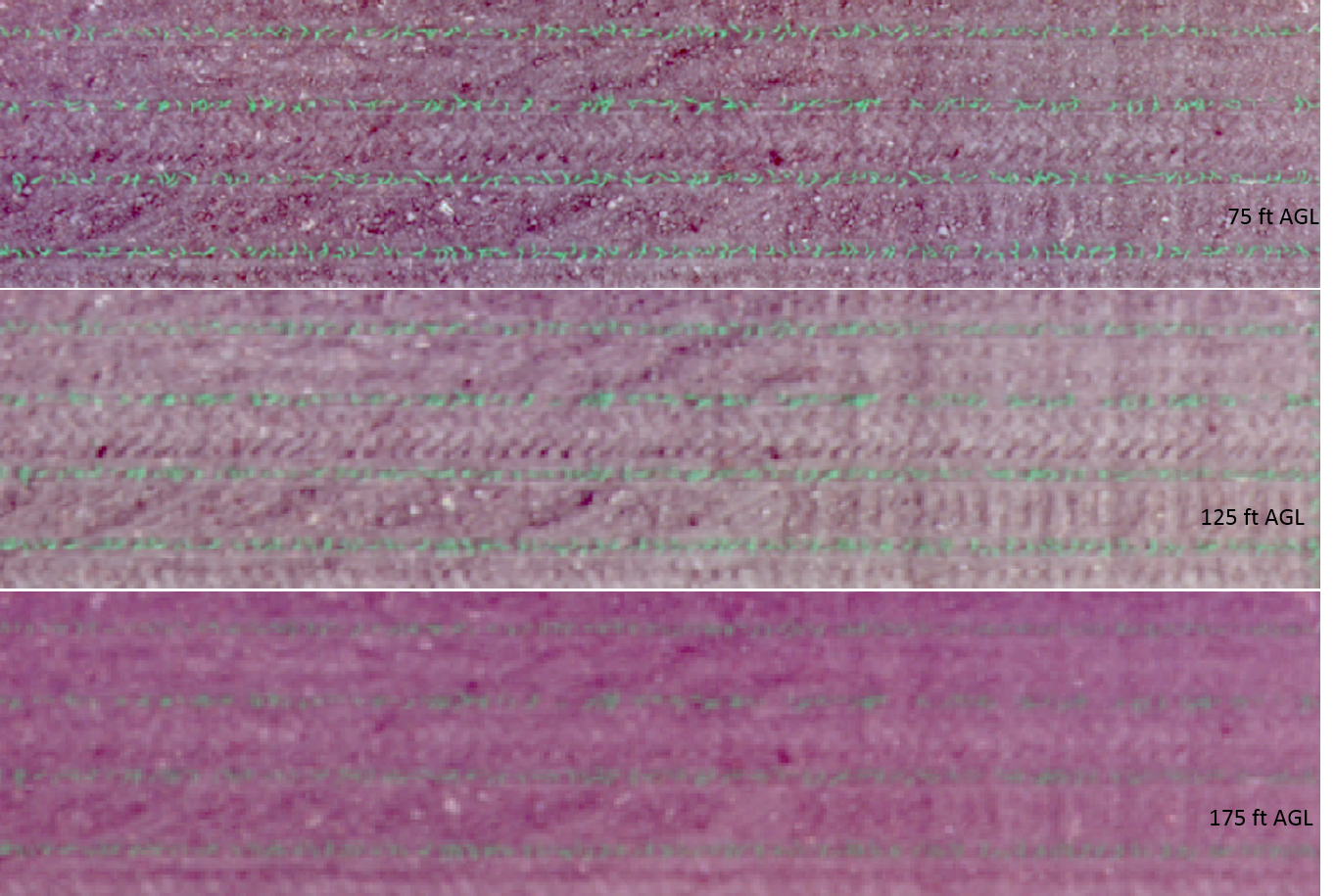
Figure 1. Flight altitudes and its impact on image resolution in a corn field (multispectral camera).
Weed Spotting
I have noticed this season the occurrence of weeds either in patches or spread throughout the whole field in some of our plot research imagery. I can easily spot weeds in imagery collected with our multispectral camera at 200 ft AGL, but I believe that one could see that even flying a little higher and using the NDVI layer to look for those. One tip if you want to try spotting your weeds: look at the NDVI layer using a black and white symbology, instead of colors normally seen for NDVI (ranging from red to green). I have spotted broadleaf weeds in small grains (Figure 2) and corn trials using the NDVI layer. I believe this is the kind of information that could be used by a farmer to rank the fields that should be sprayed first, so weeds do not get out of control in fields with higher weed pressure.
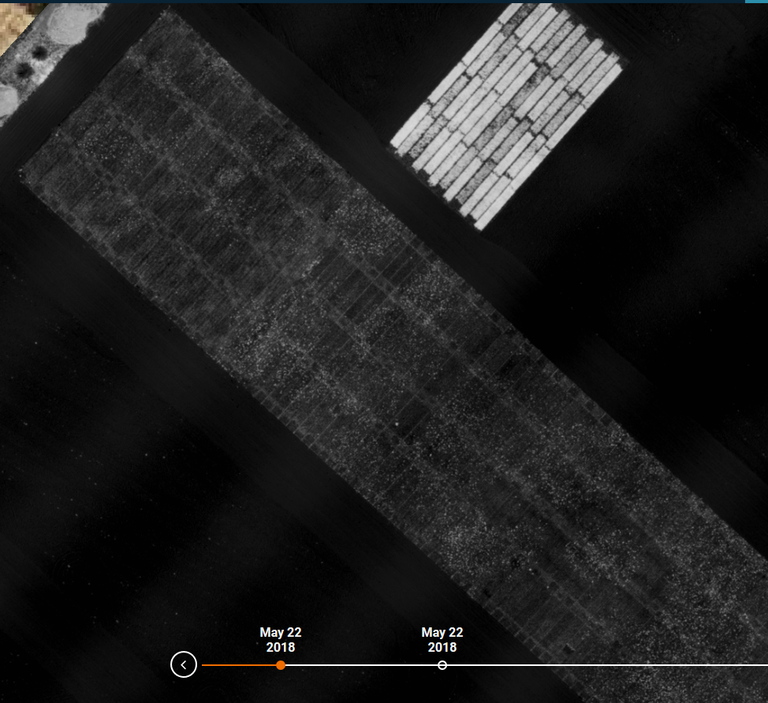
Figure 2. NDVI image showing occurrence of Canada thistle (the bright patches in the lower plots) in an organic small grain field.
Paulo Flores
Paulo.Flores@ndsu.edu
Precision Ag Specialist
Decoration Day
Today is Memorial Day in the United States. Decoration Day, as it was formerly called, is a day when we pause to remember those whose lives were taken in service to the United State of America. Today you may be taking the camper and boat out for the first time this season; fencing, because it’s time for the cows and calves to get out of the calving area; planting (your field or garden) or maybe taking a much needed break if we received the rains that were predicted; or maybe today you’re simply remembering a loved one that’s no longer with you. In one way or another, each of us is affected by this day. Memorial Day services will be held all around the state. Some will be attended by over 200 people and some will have 20 in the crowd. No matter the size, the significance is the same. So between the hot dogs, fence clips, and seeds I urge you to take a couple minutes to remember why we celebrate this national holiday. Listen to the veteran tell the story about their friend who “never made it back” and be grateful for the opportunities we are granted.
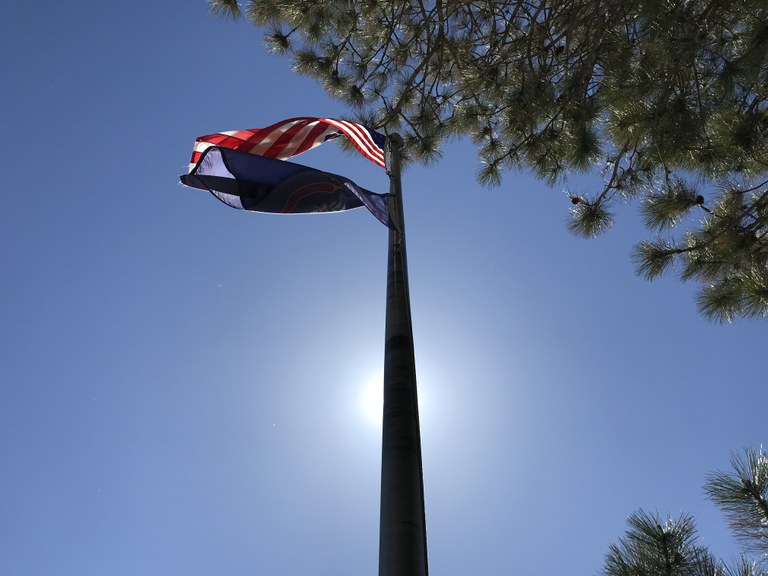
More information about the history of Memorial Day can be found here: http://www.usmemorialday.org/.
Mary Berg
mary.berg@ndsu.edu
Extension Specialist
NDSU Crop Management Field School Set for June 14
North Dakota State University Extension’s annual crop management field school will be offered Thursday, June 14, starting at 9 a.m. at the Carrington Research Extension Center (CREC).
The school will provide updates on crop, pest and soil management recommendations using hands-on training in field research and demonstration plots.
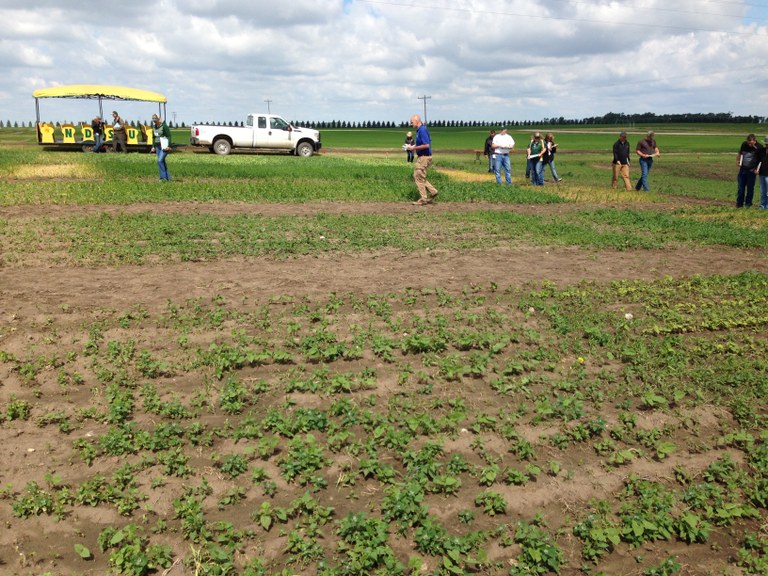
The program is designed for crop advisers, but it also will be beneficial for farmers.
Field sessions include:
- Weed identification - identify about 60 living weed exhibits, plus receive brief reviews on selected weed biology and control
- Herbicide site-of-action - identify herbicide classes by examining crop and weed injury symptoms
- Cover crops - review trials and results with small-grain and row crops
- Measuring soil quality - review field tools and tests
- Late-season wheat management - review strategies for disease control and plant nutrition
- POST soybean herbicides - examine the balance between crop injury and weed control
School instructors include NDSU agronomists and crop specialists Ezra Aberle, Ryan Buetow, Greg Endres, Mike Ostlie, Tom Peters, and Joel Ransom; and soil health researcher Caley Gasch.
Preregistration is required. A total of 50 participants will be accepted on a first-come, first-served basis. Participants will receive reference materials, refreshments and a noon meal. Certified crop advisers participating in the event will receive 5 continuing education units in crop, pest, and soil and water management.
For more details and preregistration information, visit http://www.ag.ndsu.edu/CarringtonREC/ or contact the CREC at 701-652-2951. A completed preregistration form and $100 fee is required by June 11.
Greg Endres
Gregory.Endres@ndsu.edu
Extension Agronomy Specialist
And They're Off!
A quick view of what a day of planting season looks like at the Carrington Research Extension Center.
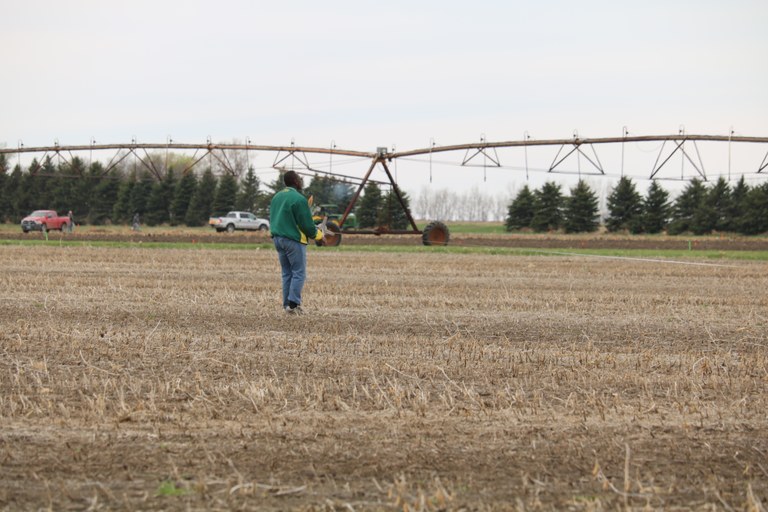
Measuring plots.
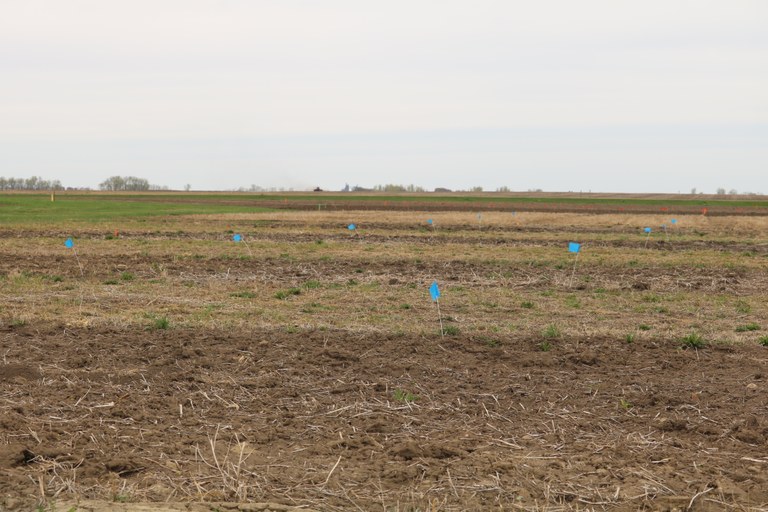
Plots flagged and ready to plant.
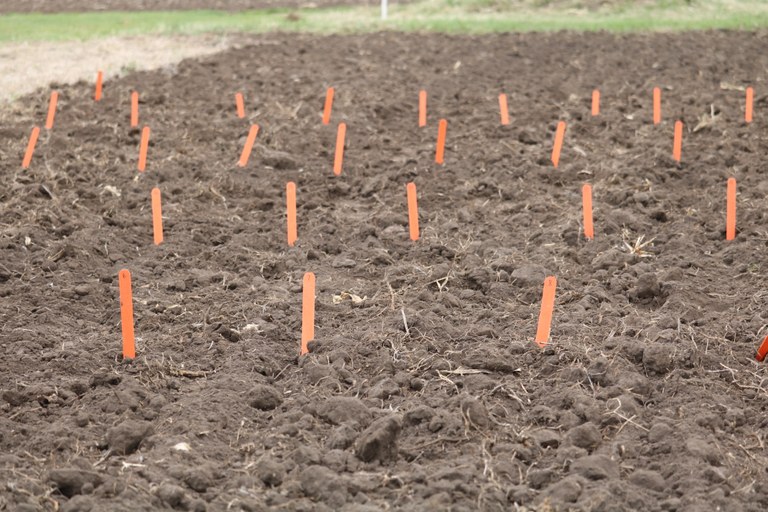
Hand-planted plot.
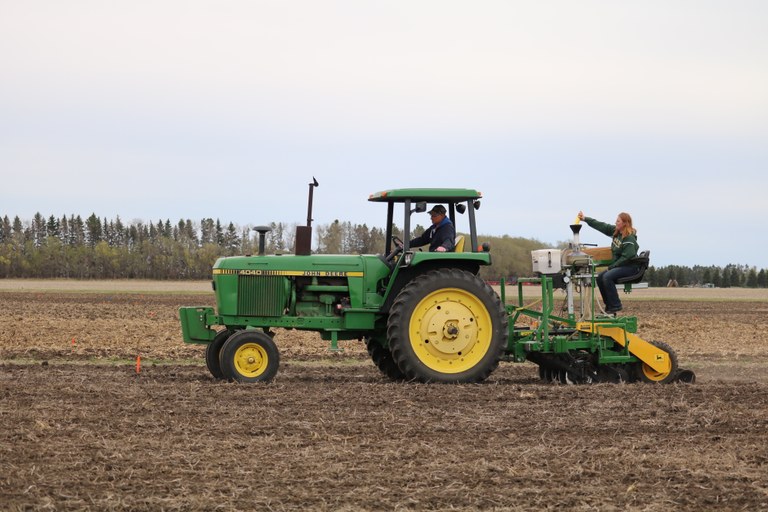
Plot-sized planter.
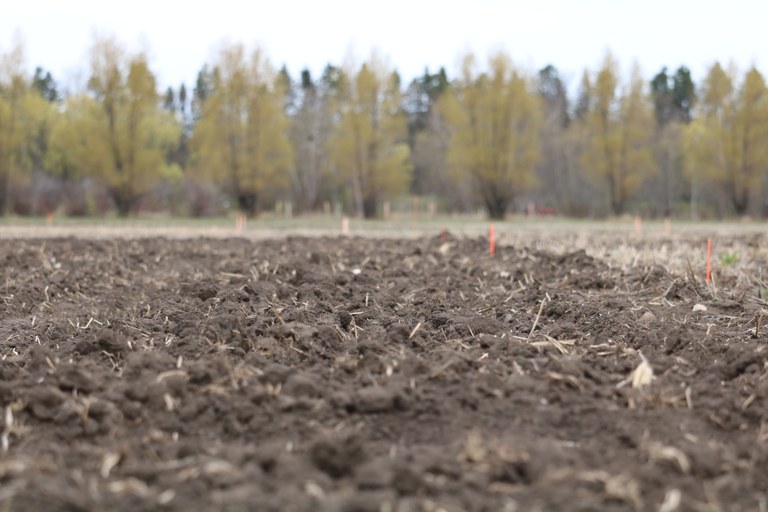
Can you pick out the rows from the plot planter?
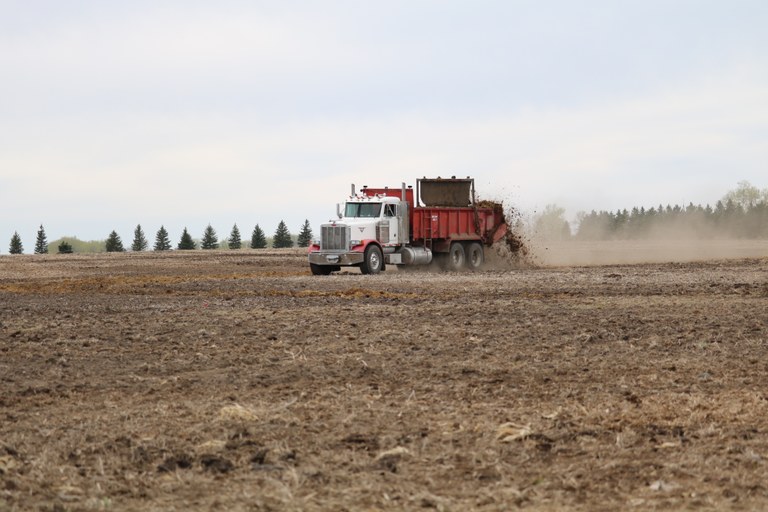
Spreading manure from the CREC Livestock Unit.
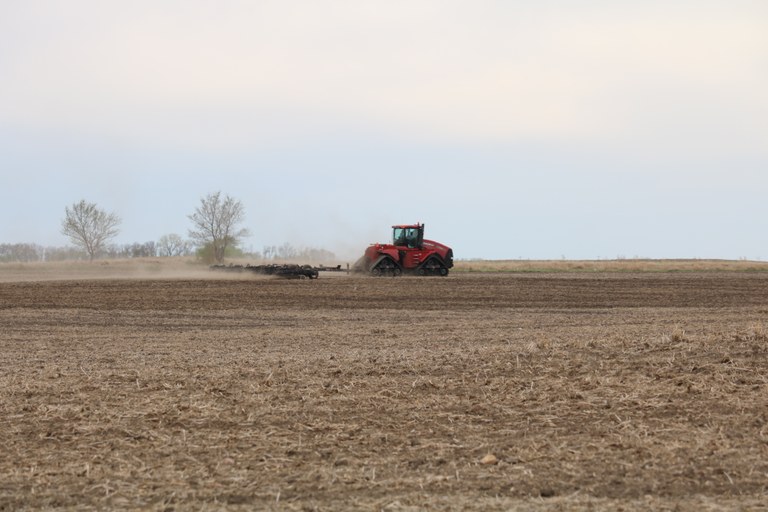
Foundation Seedstocks field preparation.
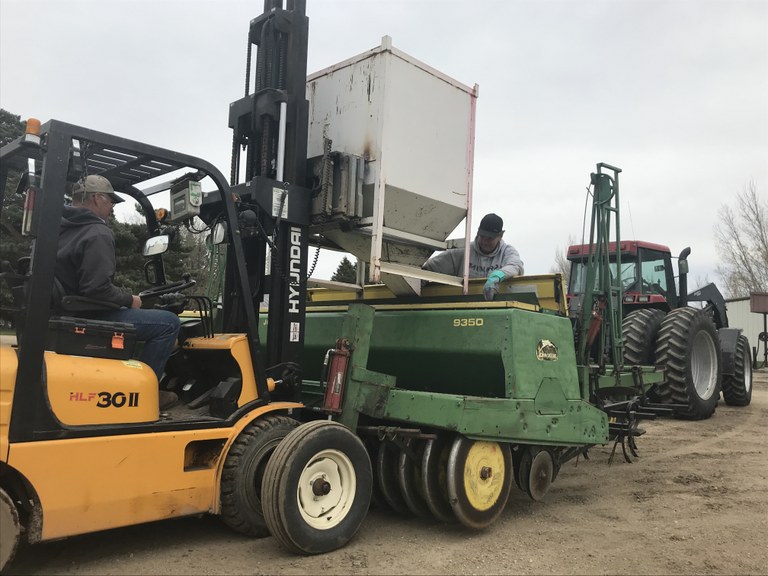
Foundation Seedstocks filling the drill.

"It's so quiet in here now, it's weird!" - Lab Crew
Please keep safety at the forefront of your thoughts during this planting season.
Mary Berg
Mary.Berg@ndsu.edu
Extension Specialist
30 Days Hath…A New LIP Rule Change!
Livestock producers have thirty days…not 31 or 60 days…to report livestock losses (deaths) to the Farm Service Agency (FSA) for payment via the Livestock Indemnity Program (LIP). The Notice of Loss must be provided to the local FSA office within 30 days after the loss becomes apparent as a result of a qualifying event.
LIP provides benefits to agricultural producers for livestock deaths due to eligible losses in excess of normal mortality. For beef calves under 400 pounds, normal mortality is 4.6%
Eligible loss conditions are eligible adverse weather events, eligible disease, and eligible attack.
A qualifying weather event in North Dakota includes blizzards, extreme cold weather, winter storm (a winter storm is a three day event with high winds, freezing rain or sleet, heavy snowfall and extremely cold temperatures), lightning, flood, extreme heat, wildfires and straight-line winds.
According to an April 24, 2018 news release, FSA has made an administrative change to LIP:
“In the event of disease, this change by USDA’s Farm Service Agency (FSA) authorizes local FSA county committees to accept veterinarian certifications that livestock deaths were directly related to adverse weather and unpreventable through good animal husbandry and management. The committees may then use this certification to allow eligibility for producers on a case-by-case basis for LIP.”
For example, if a blizzard struck on April 10 and calves died during the storm due to exposure to the storm, i.e. born in the snow and then covered with snow or chilled and died. The producer would have until May 10 to report a Notice of Loss to the Local FSA. The event would likely qualify as an eligible adverse weather event since it was a blizzard.
The LIP administrative change will now allow additional loss claims.
An adverse weather event like extreme cold, blizzard, or winter storm can weaken a calf which then develops an illness like scours, pneumonia, and/or enterotoxemia, doesn’t recover and later dies. This calf death could be an eligible loss.
If you have death losses after an adverse event, immediately schedule an appointment with your veterinarian so they may diagnosis if the loss was due to adverse weather or not.
For example, if a calf was stressed during the April 10 blizzard, but didn’t die that day and instead the calf was chilled, then developed pneumonia and died 7 days later. This death can now be attributed to the blizzard if a veterinarian provides a certification. The producer would have 30 days after the calf death to report a Notice of Loss. In this example, the calf died April 17 and would need to be reported to FSA before May 17.
The 2018 payment rate for beef calves weighing less than 400 pounds is $468.72. For application criteria please contact your local FSA office.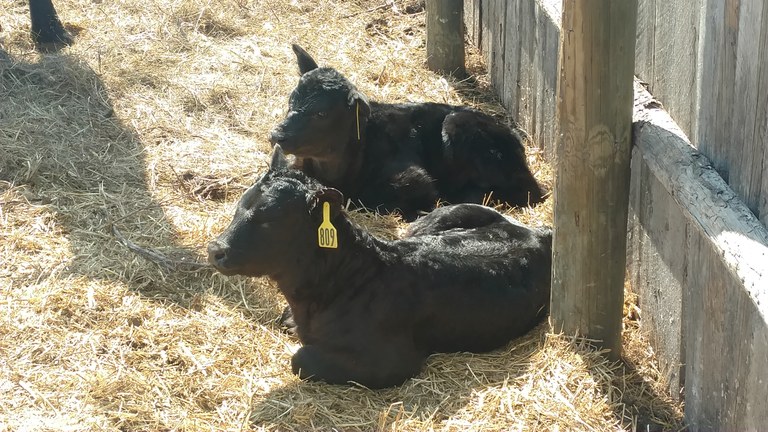
New calves enjoying the spring sunshine.
Karl Hoppe
Karl.Hoppe@ndsu.edu
Extension Livestock Specialist
Pinto Bean Yield With Starter Fertilizer
The NDSU Carrington Research Extension Center (CREC) has been conducting research since 2009 with pinto bean to measure response to phosphorus (P)-based starter fertilizer primarily with liquid 10-34-0 using different application methods and rates. Ten trials were conducted on a well-drained loam soil with 2.6 to 4 percent organic matter and generally low P levels.
Seed yield averaged across seven trials with in-furrow (IF) -applied 10-34-0 at 2 to 3 gallons per acre (gpa) increased 3.1 hundredweight (cwt) per acre (11 percent), compared with the untreated check (Figure 1). However, plant population was reduced 4 percent with the IF fertilizer application compared to the untreated check. Also, yield was similar between low (2.5 to 3 gpa) and high (5 to 6 gpa) rates of IF-applied 10-34-0. The high fertilizer rate reduced plant population by 13 percent.
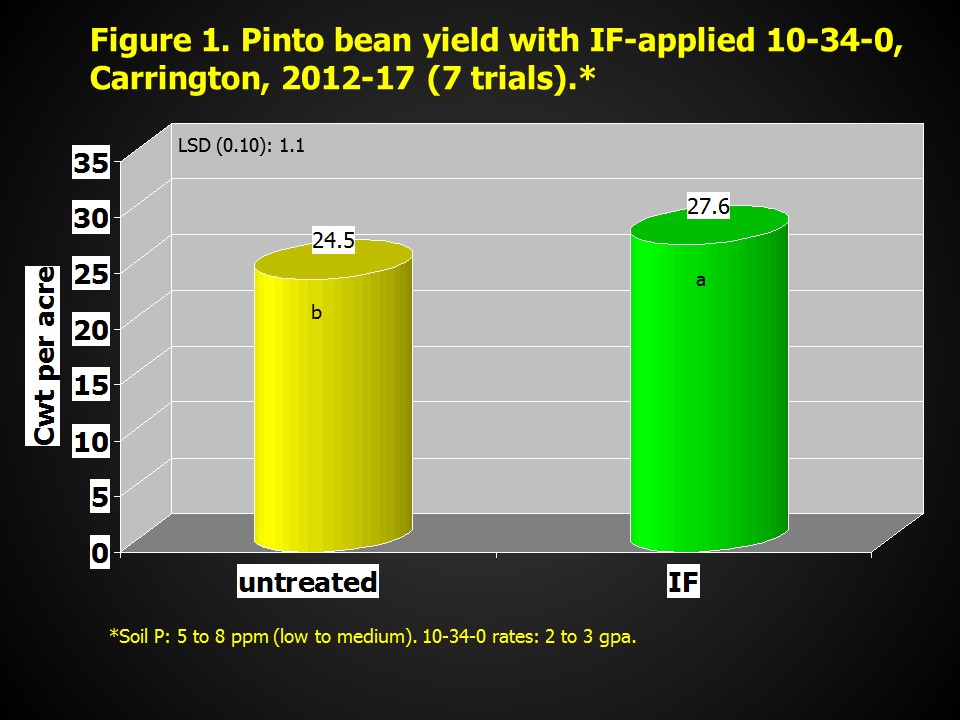
Yield between IF- and band-applied (2 inches from seed) 10-34-0 at 3 to 6 gpa was statistically similar averaged among seven trials (Figure 2). However, the plant population was reduced an average of 13 percent with IF-applied 10-34-0, compared with band-applied 10-34-0 and the untreated check. The banded fertilizer application provides soil separation between fertilizer and bean seed that reduces the risk of seed damage from fertilizer salts and ammonium-nitrogen.
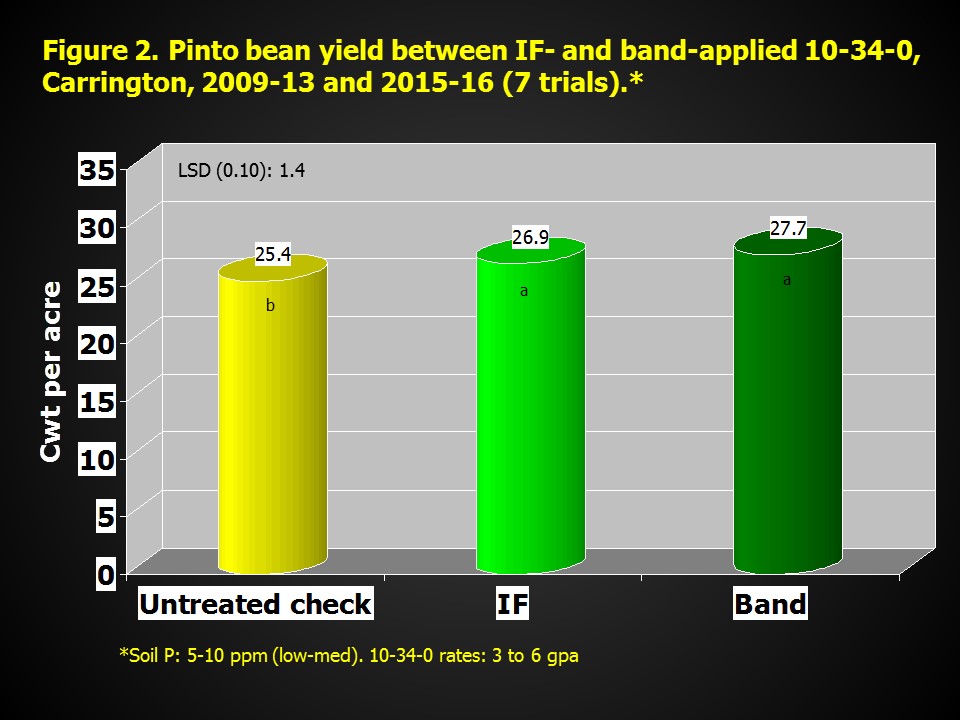
NDSU Extension circular A1883 ‘Pinto bean response to phosphorus starter fertilizer in east-central North Dakota’ contains the previously mentioned results plus additional research summaries. The publication will soon be posted on the web and currently can be obtained by contacting the CREC (701.652.2951).
Greg Endres
Gregory.Endres@ndsu.edu
Extension Agronomy Specialist
Tracing the Roots of Arbor Day
Arbor Day is a long-standing tradition of celebrating trees across the country, started in 1872 in Nebraska by J. Sterling Morton. Tree enthusiasts in Dakota Territory hopped on board in 1882 to plant, distributing seeds and seedlings to schoolchildren across the open prairie. Today, nearly 150 years later, every state celebrates its own officially proclaimed Arbor Day. Nationally we celebrate Arbor Day on the last Friday in April. For North Dakota, the official State Arbor Day is the first Friday in May.
For Tree City USA towns, an annual Arbor Day is required to maintain certification. North Dakota is home to 53 Tree Cities USA, ranging in size from the state’s largest city - Fargo, population 120,000 - to the smallest Tree City USA currently on record – Sibley, population 20.
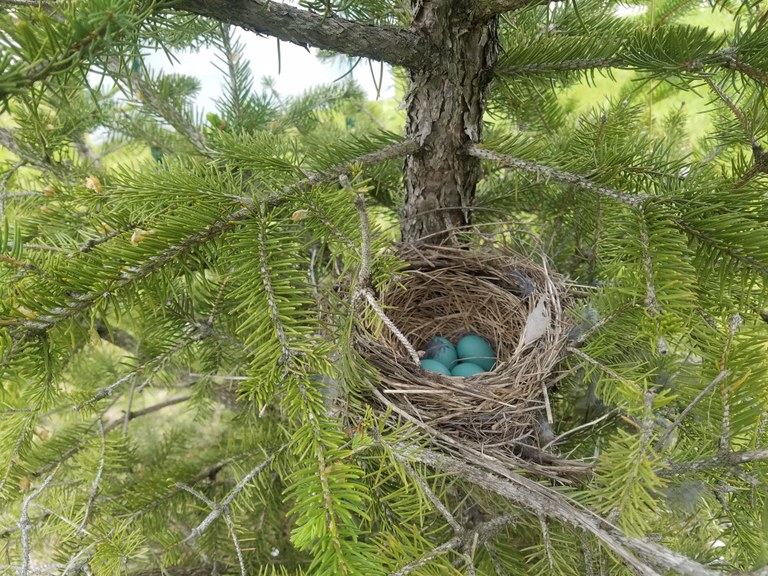
Arbor Day gets students outside to discover things like this spruce tree with a robin’s nest full of eggs – McVille, 2017.
Community Arbor Day events are as varied as the number of communities in which they are celebrated and are scheduled anytime that is convenient, but most celebrations include planting one or more trees. Many towns celebrate at the local school, and enthusiastic students enjoy getting their hands dirty to help plant a tree.
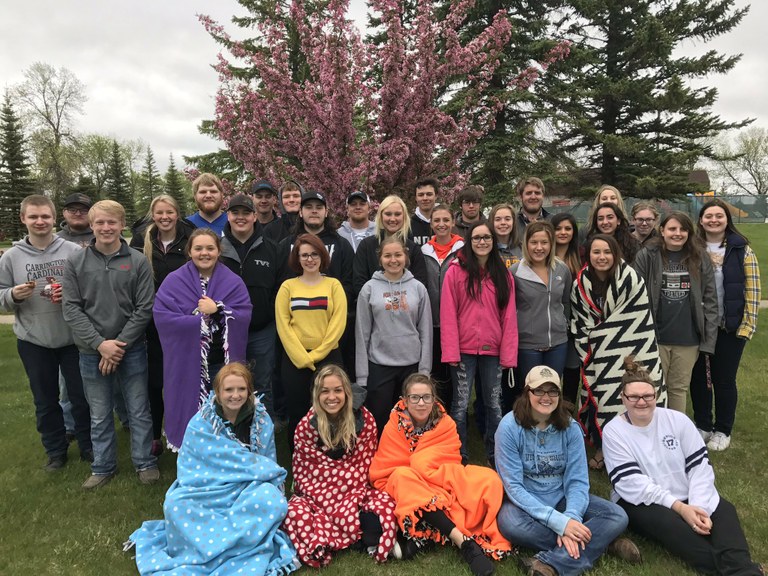 In Carrington, 1st graders assist with planting a tree at the city park. The photo shows seniors posing in front of the tree they planted 12 years earlier!
In Carrington, 1st graders assist with planting a tree at the city park. The photo shows seniors posing in front of the tree they planted 12 years earlier!
North Dakota’s state Arbor Day has been hosted in communities across the state in conjunction with reasons to celebrate: President George H. Bush presented and dedicated an American elm tree located near the Capitol steps in commemoration of the state’s Centennial in 1989. Events in 2003 and 2004 celebrated the bicentennial of the Lewis and Clark expedition. Northwood (2008) and Dickinson (2010) featured tree-planting recovery efforts following catastrophic tornadoes in those communities. Trees were planted at the International Peace Garden (2012) in honor of the 100th Anniversary of Girl Scouts. Cando (2014) and Watford City (2017) hosted the State Arbor Day to celebrate 25th Anniversaries as a Tree City USA.
This year, go out on a limb – grab a shovel and celebrate the beauty and benefits of trees in your community.
Gerri Makay
Community Forestry Program Manager – ND Forest Service
Planting Plans 2018
The fall and winter seed-conditioning season has finally wrapped up at the CREC. It started in late July and finished in late February. We conditioned 36 different seed lots. Depending on the crop type, three or six pound samples of each seed lot are sent to the ND State Seed Department (SSD) for purity and quality analysis. About 25 seed samples representing carryover seed lots are also sent to the SSD for updated germinations. With the test results now completed, it is time to finish planning for the next cropping season.
In late January, the staff of the CREC Foundation Seedstocks Program starts putting together planting plans for the next growing season. These plans are time consuming. Proper planning involves scrutiny of the crop and variety that was planted on a field during previous growing seasons. Often, multiple changes occur to most fields before the best possible variety is selected for a field. Listed below are some of the points we follow to develop our planting plan.
- All of the CREC fields have a unique letter or number that provides field identification. A field map labeled with an identifier shows the location of each field. This helps with tracking the crop history from one year to the next. If needed, we can look back over many years to verify the crop and variety that was planted on a specific field.
- All fields are soil sampled in the fall following harvest. Knowing the fertility status we have in the soil allows for proper fertilization for the next crop. Commercial fertilizer or beef manure is applied as needed to the fields in either the fall or spring. Manure is applied to small grain fields that will be planted to a broadleaf crop the next season. We can’t apply manure to fields to be planted to a small grain due to the potential of volunteers from the manure.
- Field history is looked at going back multiple years. The large number of crops and varieties help the CREC spread out the rotations between crops. When needed, we can avoid fields for 4 or 5 years before planting the same crop.
- It is vital to follow the SSD’s requirement of crop rotation for durum. The field must have a previous two-year history of no wheat. The CREC dedicates certain fields to having only either durum or wheat in their rotation. The SSD’s requirement and this practice is critical to help maintain durum purity.
- The CREC always tries to plant crop opposites in sequence. We are looking for seed separation opportunities during the conditioning processes. To create a seed separation you must have potential differences. The differences to consider could be length, size, weight and width.
- The CREC uses their input products following best management practices. We use seed treatments as needed. Pre-plant and post-emerge herbicides help with weed control. The CREC also will use a fungicide or insecticide when necessary to ensure good production and a quality seed. The products used on each field are documented and filed for future reference. The herbicide history is especially important when making decisions on the field’s next crop to be planted. With the many crops grown by the CREC, it is very important to follow label directions and know the plant-back restrictions for the next growing season.
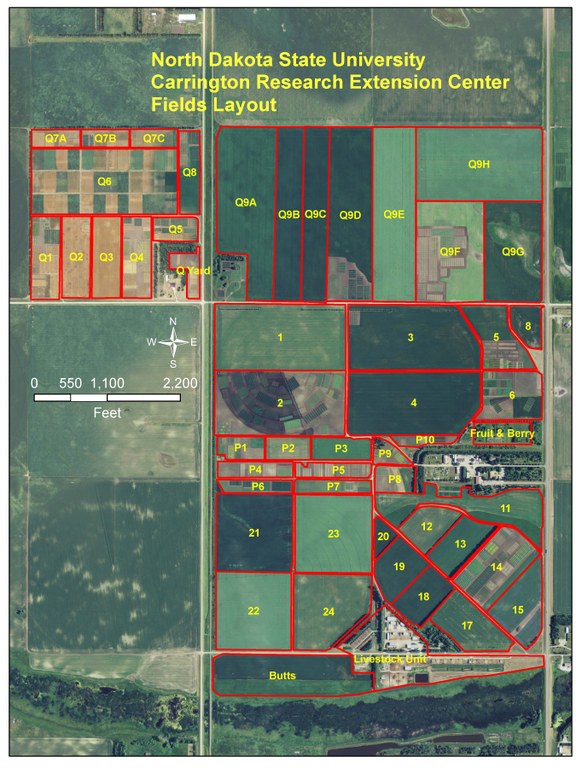
If you wish to see our research closer up during the growing season, please stop at the main office so we can point you in the right direction. We have several staff collecting data and carrying out daily tasks and we want everyone to be safe. We wish you the best of luck as you gear up for planting in 2018.
David Copenhaver
David.Copenhaver@ndsu.edu
Foundation Seedstocks Project Leader
2017 Farm Business Management Data
While many are still waiting for spring to show up and activity to start in the fields, the North Dakota Farm Management Programs (FBM) are finishing up our compilation of data from 2017. This data comes from the actual numbers from farms enrolled in FBM Programs throughout North Dakota. By looking at these benchmark numbers, farmers are able to make more informed management decisions to accomplish not only the goals they have set for their farm but also for their families.
The Average Net Farm Income for 2017 for the Region 3 area, including farms in the Carrington FBM program was $116,714, down from $166,574 in 2016. Much of the decrease can be attributed to lower commodity prices during the year. It is important to remember that these numbers are an average and that each farm’s own set of numbers comes from their unique situations. Therefore, the numbers can vary greatly from farm to farm.
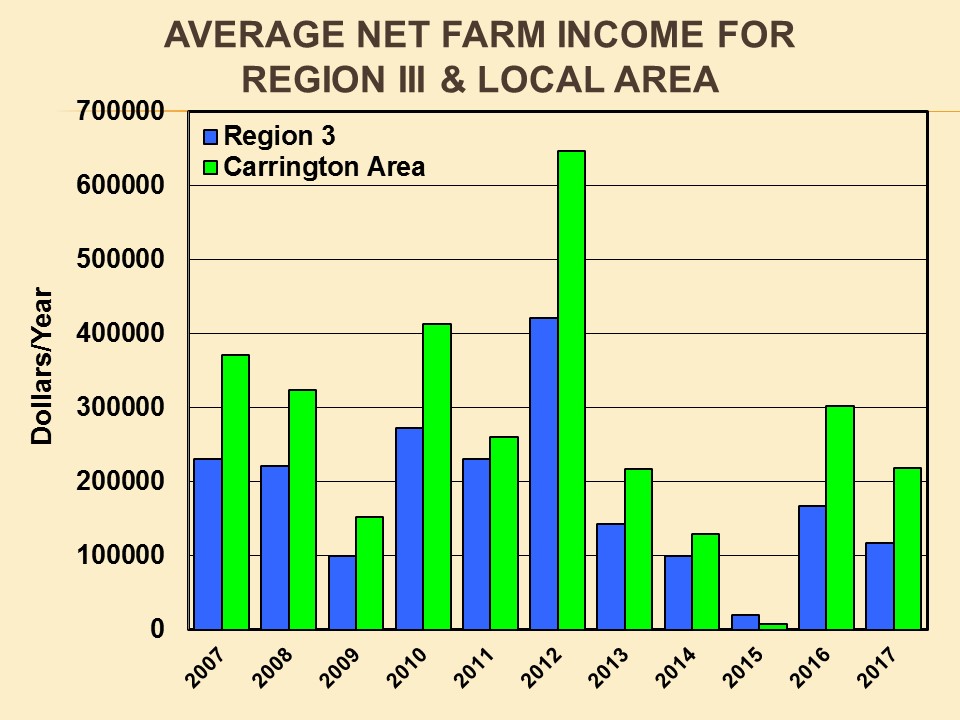
Other data is available from the FBM Program, including the average ratios, working capital and depreciation costs per farm. The data is broke down even further by enterprises and it is possible to see the average incomes and expenses for each crop or what the net return per beef cow was. Comparing your own numbers to the average numbers, as well as the numbers from each profitability group, can help make decisions easier. For example, if a farm in Region 3 had a machinery cost per acre of wheat on cash rented ground of $85 in 2017 they are above the average machinery cost and would be closest to the machinery cost for the low 20% profit group. They would be encouraged to look at why that machinery cost is so high. On the other hand, if a farm in Region 3 spent $91 per acre on fertilizer on rented corn ground, they would be slightly above the average of all farms, and fall closest to the middle 40-60% profitability group.
For anyone wanting to take a more in depth look at the numbers, more information is available at www.ndfarmmanagement.com or you can contact your local FBM Instructor.
Jory Hansen
j.hansen@ndus.edu
Farm Business Management Instructor
Spring is Here, Right?
The calendar says yes, the new calves at the Livestock Unit tell us yes, and my colleagues’ cheery-looking apparel choices agree as well. Despite the dreary weather and cold temperatures we are ready to look toward the new beginnings spring promises!
We are excited to announce that Dr. Bryan Neville has joined the NDSU Carrington Research Extension Center as Animal Scientist. Dr. Neville’s first official day in this position was Monday, March 26.
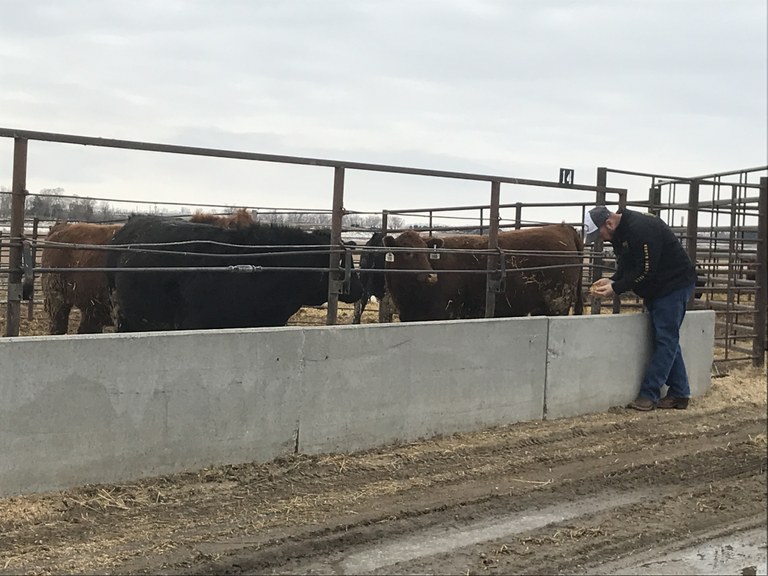
Dr. Bryan Neville, examining a feedlot ration at the CREC's Livestock Unit.
Dr. Neville’s research interests include nutrition and management strategies in backgrounding/feedlot settings and drylot cow management. He will carry on the tradition of the CREC’s livestock program, conducting applied research that our ND producers can implement into their operations.
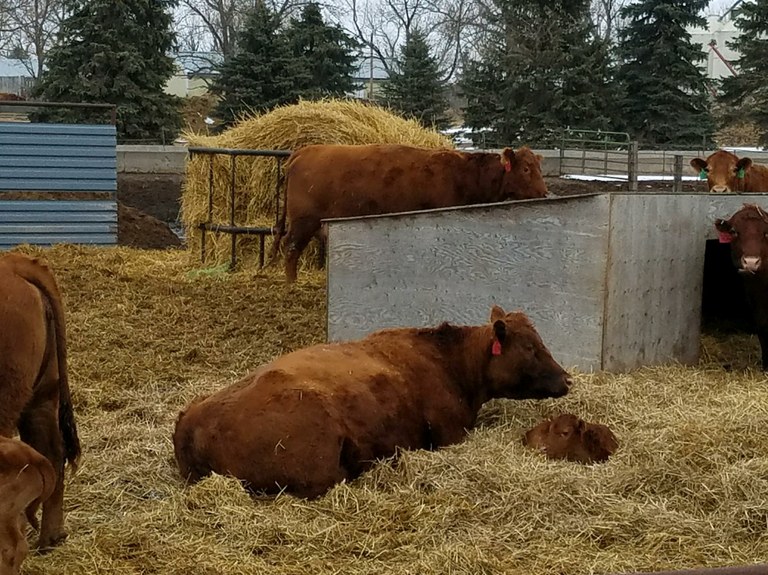
CREC drylot cow and new calf enjoying the dry straw.
Dr. Neville earned his Ph.D. in Ruminant Nutrition from North Dakota State University in 2010. Bryan earned his M.S. degree also in Ruminant Nutrition from NDSU in 2007. Most recently he has worked in the nutrition consulting industry. Previously, Dr. Neville served as the Director and Animal Scientist at NDSU’s Central Grasslands Research Extension Center near Streeter.
Bryan and his wife Tammi enjoy hunting with their dog, Bella, fishing and are excited to join the Carrington community.
Dr. Neville can be contacted by calling the Carrington Research Extension Center at 701-652-2951 or by email at bryan.neville@ndsu.edu. Please join us in welcoming Bryan back to North Dakota State University and NDSU Agriculture.
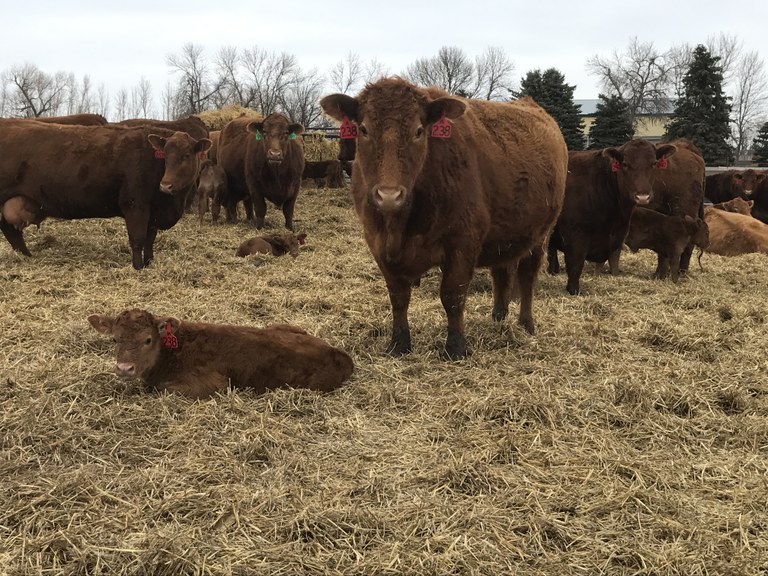
The start of the 2018 calf crop at the CREC.
Mary Berg
mary.berg@ndsu.edu
Area Extension Specialist


